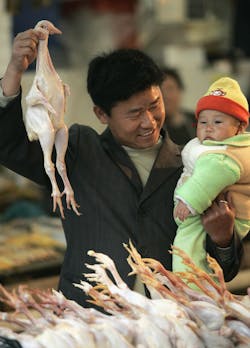Imagine picking up a pack of chicken drumsticks at the supermarket and scanning it with your iPhone to see exactly where the bird was slaughtered and when the meat arrived in the store cooler. For Chinese shoppers, chastened by years of food-safety scares, that's now a reality.
Tyson Foods Inc. has added to some of its chicken products a quick-response code that can be scanned with a smartphone. The U.S. company, which supplies one of every five pounds of meat eaten at home, has international ambitions and in China that means trying to entice consumers for whom the provenance of their food matters a great deal.
While Americans generally buy their meat from grocery stores, Chinese traditionally go to the local market. Many are still used to buying just-slaughtered chicken that's still warm, according to Tyson Chief Global Growth Officer Sally Grimes.
"The definition of fresh to the Chinese consumer is different," she said.
While national differences remain, Chinese patterns of consumption are evolving. The country is now the world's largest consumer of pork, the second-biggest for chicken and the No. 3 for beef, as its emerging middle class eats more meat than its forebears. And as they migrate to cities, they're buying more of it pre-packaged from a store. Despite the slowdown in emerging markets, China and India are expanding at a faster rate than the U.S. and offer Tyson a chance to increase sales.
Time-Strapped Consumers
"You can't help but say, 'we better figure out the rest of the world,'" Grimes said in an interview Feb. 16.
Springdale, Arkansas-based Tyson gets about 13 percent of its revenue from outside the U.S. It took a deep dive into where it could find growth opportunities after its 2014 acquisition of Hillshire Brands Co. and found what it was looking for in China and India. Asian food sales growth is likely to exceed global increases through at least 2020, according to Euromonitor, as diets increasingly resemble those in developed nations.
A man shows his kid a slaughtered chicken at a market April 22, 2006 in Shanghai, China. The 17th person in China infected with bird flu has died in the central Hubei Province, and two dead birds in the northeastern Liaoning Province were confirmed killed by the H5N1 strain of virus, authorities announced on April 20. China has reported 17 human cases of bird flu, which have resulted in 12 deaths, according to state media.
(Photo: Getty Images | China Photos)
The company is open to developing dishes internally or making deals for this expansion, Grimes said. For time-strapped Chinese consumers, Tyson is offering frozen prepared foods such as New Orleans-style chicken wings that can be quickly sauteed in a pan. It's also working with e-commerce businesses to expand online food sales.
India Push
Tyson's business in China used to be focused on selling commodity meat to multinational restaurant chains such as Yum! Brands Inc. In 2014, it put its Chinese growth plans "in a holding pattern" after sales of allegedly out-of-date meat from another U.S. supplier and avian influenza hurt demand. n is also making a push in India, where it’s trying
The company's current approach in China mirrors efforts in the U.S., where over the last decade it has shifted from relying on commodity meat sales to providing more products that can charge a premium because they're cut, seasoned and packaged to fit changing consumer tastes and requirements.
Tyson is also making a push in India, where it's trying to expand an existing fresh- and frozen-chicken business and also move into other kinds of food. Its efforts there have included tracking ice cream shops in a bid to locate hard-to-find cold-storage capacity. Grimes declined to provide sales targets or projections for the international expansion other than to say Tyson is looking for "substantial growth."
A Siberian tiger eats a chicken in a pond to cool down at the Chongqing Safari Park August 5, 2007 in Chongqing Municipality, China. The park, which has 30,000 animals in 430 categories, keeps animals cool during a heatwave as temperatures hit 38 degrees Celsius (100 degrees Fahrenheit).
(Photo: Getty Images | China Photos)
"We are not going to do it overnight, and there is a lot of work ahead, but we are on a path," she said.
(Top photo by Mario Villafuerte/ Getty Images)












